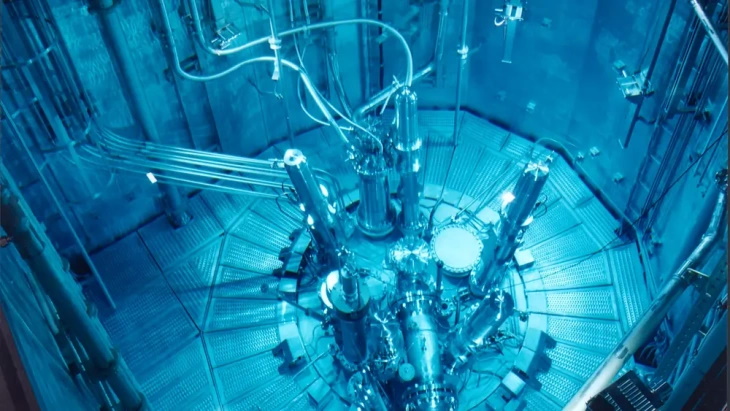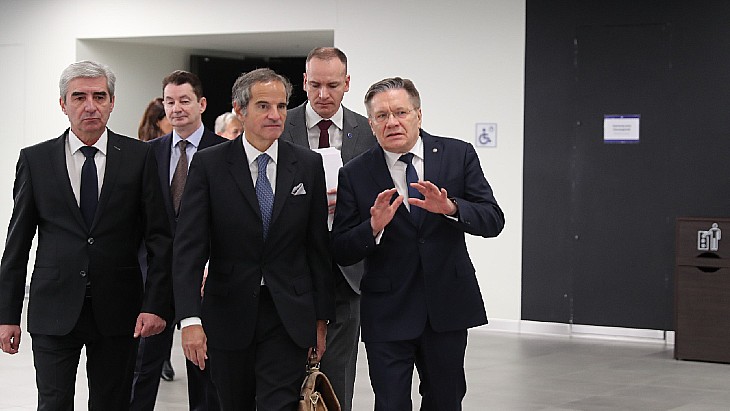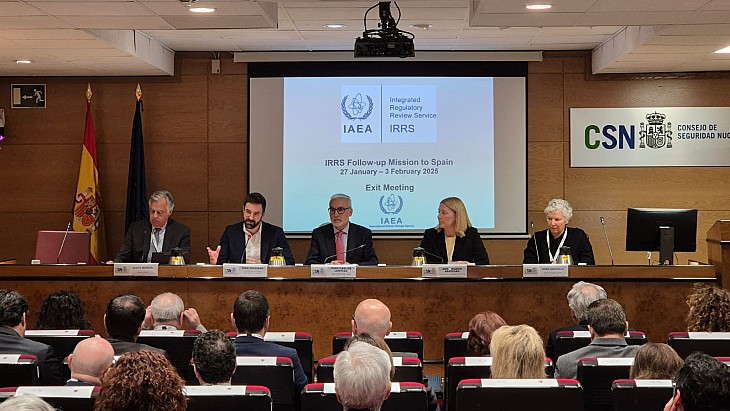Private players will benefit India nuclear, minister says
India's nuclear energy sector will benefit from the entry of private sector players in the same way that the country's space economy has done, Minister of State Jitendra Singh has said.
_84571.jpg)
Singh was speaking to The Indian Express days after Minister of Finance Nirmala Sitharaman included promises to amend Indian legislation to encourage private sector participation in the nuclear sector in the Union Budget for 2025-2026.
"We are inviting private participation in the nuclear industry … we expect that the participation of private players would energise the nuclear power sector and help it grow rapidly. We have seen the kind of impact private players have had in the space sector. Something similar can happen in nuclear as well," said Singh, who is the minister in charge of both the Department of Atomic Energy and the Department of Space.
Nuclear energy accounts for about 3% of India's current installed generating capacity, but it is aiming to grow its nuclear capacity from 6780 MWe today to 22,480 MWe by 2031. The government is targeting 100 GW of nuclear power for 2047 under its Viksit Bharat development strategy - a goal which Singh said is "very realistic".
"It is a challenging target, but not unachievable," Singh said, pointing to India’s space economy which is currently estimated to be worth USD8.4 billion, and projected to grow to USD44 billion by 2033: "Once a certain threshold has been reached, and the right atmospheres created, the growth can be very fast."
According to information from the US Department of Commerce International Trade Administration, the Indian government announced access for the Indian private sector to its space activities and programmes in May 2020, reflecting a major shift in its space policy. In February 2024, restrictions on foreign direct investment or ownership approvals for India's emerging private space industry were further relaxed, potentially opening up opportunities for international partner companies.
India's Atomic Energy Act of 1962 prohibits private control of nuclear power generation in India: only two government-owned enterprises - NPCIL and Bharatiya Nabhikiya Vidyut Nigam Limited (BHAVINI, set up to build and operate fast reactors) - are legally allowed to own and operate nuclear power plants in India. The act was amended in 2016 to allow public sector joint ventures, but private sector companies and foreign investments are not allowed to invest directly in nuclear power in India. India's civil liability for nuclear damages, which would allow operators to have legal recourse to the reactor supplier, with no limit on supplier liability, in the event of a nuclear accident, has also been a stumbling block for overseas nuclear power plant vendors.
Domestic progress
The Indian cabinet in 2017 approved the construction of ten domestically designed 700 MWe PHWR units using a fleet mode of construction to bring economies of scale as well as maximising efficiency. The first two of these units will be Kaiga 5 and 6, in Karnataka, and this week the heavy engineering arm of Indian engineering company Larsen & Toubro (L&T) announced that it has shipped the third steam generator for the plant. Excavation works for the units began in May 2022.
"L&T is committed to deliver 6-8 nos 700 MWe Steam Generators every year and for the success of 220 MWe Bharat Small Reactor (BSR) programme to ensure net-zero carbon emissions by 2070," the company said. The steam generator was manufactured at L&T’s AM Naik Heavy Engineering Complex at Hazira, Gujarat.
EU project seeks to develop new research reactor fuel
A new European research project, named EU-CONVERSION, has been launched with the aim of accelerating the conversion of high-performance research reactors by testing candidate low-enriched uranium fissile materials.

EU-CONVERSION is considering the conversion of Germany's FRM-II research reactor and the proposed French material test reactor Jules Horowitz (JHR), whose first criticality is expected in the 2030s. EU-CONVERSION builds on three previous projects, namely EU-QUALIFY, LEU-FOREvER and HERACLES-CP.
FRM-II currently uses fuel enriched to over 95% uranium-235 to generate its dense neutron flux - and such high-enriched uranium (HEU) is seen as a nuclear proliferation risk. TUM has agreed with the German government and the Bavarian State - who finance the reactor - to work towards converting it to fuel with lower enrichments when a suitable fuel is available. This is also a condition of the reactor's operating licence, which was issued in 2003.
The participants in the EUR12.8 million (USD13.3 million) EU-CONVERSION project - which has received funding from the European Union's Horizon 2020 research and innovation programme - are: Technical University of Munich (Germany); Framatome (France); Institut Laue-Langevin (France); Belgium's Nuclear Research Centre (SCK-CEN); CEA (France); Université Grenoble Alpes (France); Centrum Vyzkumu Rez (Czech Republic); Statni Ustav Radiacni Ochrany (Czech Republic); and Technicatome (France).
Two candidate fissile materials are being considered: one based on uranium-molybdenum (U-Mo) and one on uranium silicide (U2Si3). The BR2 research reactor at SCK-CEN will be used to expose both candidate materials to extreme irradiation conditions. The materials will spend about two to three cycles (about 55-75 days) in the core of the BR2 research reactor. Preparations for the demonstration test will begin this year, with irradiation in 2027–2028. Test analyses, after irradiation, will continue until 2030.
"Previous irradiation testing of the candidate materials was limited to a heat flux of 470 Watts/cm2," said Jared Wight, programme manager at SCK-CEN. "This allowed us to test them in normal, operational conditions. In this EU project, we go a step further and increase the heat flux to more than 500 Watts/cm2. We will exceed the normal operational limits to evaluate how the fissile materials behave under extreme conditions required by FRM-II and JHR. This is crucial to ensure the safety and reliability of the reactors."
He added: "The nuclear industry is making efforts around the world to reduce the use of highly-enriched uranium as fissile material, which is intended to prevent a potential spread and proliferation of this material. The bulk of reactors have already been converted. Now it's time for the last few - including these two reactors (FRM-II and JHR). It's a tough challenge, however, because of their specific technical specifications. But it's a challenge we intend to overcome in part with the help of our BR2 research reactor."
"Research strength and openness to technology without ideological blinkers are prerequisites for a good and safe future," said Bavaria's Science Minister Markus Blume. "We want to operate Germany's most powerful research reactor with innovative low-enriched fuel in the future - with the same scientific performance as before."
Arizona utilities team up to explore new nuclear sites
Arizona Public Service - operator of the Palo Verde nuclear power plant - is collaborating with Salt River Project and Tucson Electric Power to assess possible locations for new nuclear capacity, including retiring coal plants.
_40653.jpg)
Both small modular reactors (SMRs) and potential large reactor projects will be considered in the siting work. The trio has applied for US Department of Energy grant to begin the preliminary search for a potential site under the Generation III+ Small Modular Reactor programme, an initiative announced last year to provide to USD900 million to support SMR deployment support. If approved, the grant would support a three-year site selection process and possible preparation of an early site permit application to the US Nuclear Regulatory Commission.
The utilities said they have been "monitoring emerging nuclear technologies and have a shared interest in evaluating their potential" to support Arizona's growing energy needs.
"Energy demand in Arizona is increasing rapidly," Arizona Public Service President Ted Geisler said. "To ensure a reliable and affordable electric supply for our customers, we are committed to maintaining a diverse energy mix. While new nuclear generation would take more than a decade to develop, the planning and exploration of options must begin now."
Salt River Project (SRP) is a community-based, not-for-profit public power utility and the largest provider of electricity in the greater Phoenix metropolitan area, with more than 1 million customers. It generates electricity using solar, geothermal, biomass, wind and hydropower as well as coal and gas, and it also owns a 17.5% interest in Palo Verde. General Manager and CEO Jim Pratt said SRP was "exploring all options" to meet the area's growing energy needs affordably, reliably and sustainably. “We appreciate the collaboration with our neighbouring utilities to help determine the role new nuclear generation could play in powering Arizona’s future," he said.
New nuclear generation could provide Arizona with reliable, around-the-clock carbon-free energy to power economic growth, said Susan Gray, president and CEO of Tucson Electric Power. The utility serves more than 450,000 electric customers in Southern Arizona from an energy mix that currently includes wind and solar, coal and natural gas, but has said it is aiming to reach net-zero greenhouse gas emissions by 2050. "We know the development timeline would be long, so it makes sense for our state’s energy providers to begin this preliminary evaluation as soon as possible," she added.
According to the US Nuclear Energy Institute, the three-unit Palo Verde nuclear power plant provides 27% of Arizona's electricity and some 61% of the state's carbon-free generation. Nearly half - 45.5% - of the state's electricity comes from coal, with 10.4% from coal plants and 10.2% from solar.
The DOE opened applications for funding to support the initial domestic deployment of Generation III+ small modular reactor technologies last October, with up to USD800 million to go to two "first-mover" teams and USD100 million to address so-called gaps that have hindered plant deployments. A coalition led by the Tennessee Valley Authority has also announced that it is seeking funding from the programme, with subsidiaries of American Electric Power also seeking funding for siting work in Indiana and Virginia.
Grossi says Zaporizhzhia safety talks 'more critical than ever'
International Atomic Energy Agency Director General Rafael Mariano Grossi has held talks with Rosatom's Director General in Moscow, focusing on safety and security issues for the Zaporizhzhia nuclear power plant.

Posting on the social media site X, Grossi wrote: "Completed interagency consultations in Moscow with Russian delegation led by Rosatom’s [Alexei] Likhachev. After 3 years of talks on ZNPP nuclear safety and security, these are more critical than ever. The IAEA stands fully engaged to prevent a nuclear accident."
According to Russia's Tass news agency, the talks - which took place as the Russia-Ukraine war approaches its third anniversary - also covered safety and security risks to the Kursk and Smolensk nuclear power plants and general energy infrastucture.
It quoted Likhachev as saying "we thoroughly informed the esteemed IAEA delegation about measures that are being taken to ensure the unconditional protection" of the Zaporizhzhia plant "in terms of both nuclear safety and nuclear security".
The six-unit Zaporizhzhia nuclear power plant has been under Russian military control since early March 2022. It is located on the frontline of Russian and Ukrainian forces.
The IAEA has had a team of experts stationed at the site since September 2022 as part of efforts to help ensure its safety and security. The agency, with UN Security Council backing, has set out core principles to help ensure its safety, including that it should not be fired at or from, and should not be used as a base for heavy military equipment.
Earlier this week, Grossi travelled to Ukraine, where he inspected a substation and warned of potential safety risks for nuclear power plants from any loss of external power supplies. In an update on Thursday, the IAEA said its team at Zaporizhzhia continued to hear "multiple instances of explosions on most days, some very close to the plant. There were no reports of damage to the site".
Spain has successfully enhanced regulatory framework, says IAEA
An International Atomic Energy Agency follow-up mission has praised Spain's commitment to nuclear and radiation safety and said it has successfully implemented recommendations made by agency experts following their 2018 mission.

Integrated Regulatory Review Service (IRRS) missions are conducted at the request of IAEA member states to review and suggest enhancements to the regulatory infrastructure for nuclear, radiation, radioactive waste and transport safety. The follow-up mission to Spain had four regulatory experts from France, Germany, Switzerland and the USA, as well as four IAEA staff members.
They concluded that 12 recommendations and 20 suggestions made during the original mission had been adequately addressed. Scott Morris, Regional Administrator for the US Nuclear Regulatory Commission and Team Leader for the mission, said: "The IRRS team was very impressed with the high degree of commitment and professionalism demonstrated by our Spanish counterparts. Their focus on continuous improvement of the legal and regulatory framework for nuclear and radiological safety in Spain is commendable."
Achievements highlighted by the mission include: developing a human resource plan, including a systematic training approach for all staff; strengthening the safety culture of the Nuclear Safety Council (CSN); establishment of a national radon action plan, and ensuring CSN’s effective collaboration with the Autonomous Communities of Spain.
They also highlighted two areas of good practice - the creation of a digital platform to provide users with real-time dose data, and also a centralised digital dosimetry system to be used during emergencies for real-time radiation dose monitoring of emergency workers of all off-site response organisations.
CSN President Juan Carlos Lentijo said: "The IRRS follow-up mission reinforces Spain's commitment to nuclear safety and radiation protection. This process is a valuable tool to work on robust and future-proof safety systems, where excellence continues to be the highest priority."
Spain has seven operating nuclear power reactors producing about 20% of its electricity. It also has three plants in permanent shutdown, most reactor sites have interim used fuel storage facilities and the country has one disposal facility for very low- to intermediate-level radioactive waste. Spain had its first IRRS mission in 2008, with a follow-up mission in 2011, and in 2018 it hosted the IAEA's first combined IRRS-ARTEMIS (Integrated Review Service for Radioactive Waste and Spent Fuel Management, Decommissioning and Remediation) mission.
A follow-up ARTEMIS mission will take place later this year. The final report from the eight-day IRRS mission, which took place from 26 January, will be sent to the Spanish government in about three months.
Naarea opens test facility for microreactor development
French microreactor developer Naarea announced the commissioning of its industrial test facility and laboratory, referred to as the I-Lab. It will be used to conduct non-nuclear tests and experiments to support the development of its XAMR molten salt fast microreactor.
_56821.jpg)
Located in Cormeilles-en-Parisis in northern France, the 2400 square-metre facility will host a team of around 20 Naarea engineers as well as experimentation facilities to validate the non-nuclear environment of the technologies that will be used in Naarea's microreactors (such as pumps, gas systems, materials, valves, chemical processes, sensors, actuators, etc) and their modes of operation.
The I-Lab will have three main areas. Firstly, an industrial area dedicated to the production of coolant salts, prototyping, assembly and automated tests, and the validation of the future digital architecture of Naarea's production facilities. Secondly, a testing area dedicated to the operation of experimentation facilities designed to validate the thermohydraulic components for the eXtra Advanced Nuclear Reactor (XAMR). These facilities will primarily include test loops and testbeds on various scales. The third area will comprise three specialised laboratories: a materials and chemistry laboratory dedicated to studying corrosion and mechanical behaviour; an analysis laboratory for the development of methods, processes and analysis of materials and their level of purity; and a gas laboratory for the development of the XAMR microreactor's gas systems (filtration of noble gases, drying of inerting gases, enrichment and treatment of chlorine gases, etc).
Naarea said the tests that will be conducted using the full-size test loops at the I-Lab will allow it to make "concrete progress" in the development of its microreactor. They will be used to validate the studies and calculations performed by the engineering teams, test innovative processes and materials and develop the technical documentation being prepared for the French Authority for Nuclear Safety and Radiation Protection.
"I am proud of this new step forward achieved with our teams, which reinforces our progress and shows further evidence of our development," said Naarea founder and CEO Jean-Luc Alexandre. "This test facility is the right size to meet our needs, and will accommodate large-scale test loops as well as materials and large structures. These tests and research are essential to our industrial goals, and mark a turning point in our road to achieve them. Complementing the joint laboratory created with the CNRS [French National Centre for Scientific Research] and Paris-Saclay University, I-Lab brings us into a new physical demonstration phase that was particularly important to us."
Naarea - formally established in November 2021 - says its ultra-compact molten salt fast neutron reactor will use "the untapped potential of used radioactive materials, and thorium, unused mining waste". Once it develops the XAMR design, the company intends to target applications in areas such as transportation, agriculture and smart buildings.
Naarea says that, because of the compact size of its reactor and because there is no need for it to be grid-connected, the XAMR can "be deployed as close as possible to regions, to match energy demand as closely as possible and allow the control of security of supply, at the service of industries and communities". It expects the first units of XAMR - which can generate 80 MWt/40 MWe - to be produced by 2030.
No comments:
Post a Comment